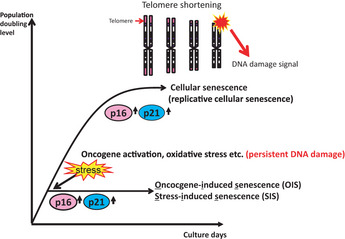Figure 1.

What is cellular senescence? Most normal human somatic cells stop dividing after a finite number of cell divisions and enter a state of irreversible cell proliferation arrest. This phenomenon is called “cellular senescence” or “replicative cellular senescence”. In human cells, the mechanism underlying replicative cellular senescence is thought to be telomere shortening. Recent studies in human cells revealed that a similar irreversible proliferation block can be induced quite rapidly when normal cells are exposed to a variety of potentially oncogenic stimuli, such as excessive levels of reactive oxygen species, treatment with DNA damaging agents or activation of certain oncogenes. Because all of these stimuli induce irreparable DNA damage in both human and murine cells, it is plausible that persistent DNA damage signals induce cellular senescence. These types of oncogenic stress‐induced senescence are now referred to as “oncogene‐induced senescence” or “stress‐induced senescence”. Both p16 and p21 upregulation contributes to the induction of both types of cellular senescence.
